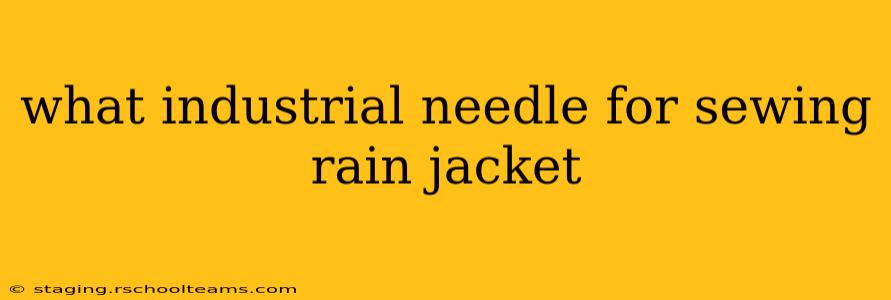What Industrial Needle for Sewing a Rain Jacket?
Sewing a rain jacket requires a needle capable of piercing the multiple layers of waterproof and often coated fabrics. The wrong needle can lead to broken needles, skipped stitches, and damage to your expensive sewing machine. Choosing the right industrial needle is crucial for a professional-looking, durable, and waterproof finish.
This guide will help you select the perfect industrial needle for your rain jacket project, addressing common questions along the way.
What type of fabric is my rain jacket made of?
This is the most crucial question to answer. Different fabrics require different needles. Common rain jacket materials include:
- Nylon: A strong, lightweight fabric, often used alone or laminated to other materials.
- Polyester: Another popular choice, known for its durability and water resistance. Often coated or laminated.
- PU Coated Fabric: A fabric with a polyurethane coating for waterproofing. This coating is often quite thick and tough.
- Laminated Fabrics: Fabrics with multiple layers bonded together, often including a waterproof membrane like Gore-Tex. These can be challenging to sew.
The thickness and texture of the fabric will dictate the needle size and type you need. Thicker, coated fabrics require stronger needles.
What needle size should I use for my rain jacket?
Needle sizes are expressed in a system that varies slightly between manufacturers, but generally, higher numbers indicate thicker needles. For rain jackets, you'll likely need a needle size between #16 and #21.
- #16 - #18: Suitable for lighter weight nylon and polyester fabrics, or thinner PU-coated fabrics.
- #19 - #21: Necessary for heavier weight fabrics, laminated materials, and thicker PU coatings.
Always check the manufacturer's recommendations for your specific fabric.
What type of needle point is best for rain jackets?
The needle point is just as important as the size. The following are best suited for rain jackets:
- Sharp Needles: These needles are best for piercing through multiple layers and fabrics without causing damage. They create a clean hole and reduce fabric damage.
- Ballpoint Needles: These needles are designed to separate the fabric yarns rather than cutting them, ideal for knit fabrics but generally not recommended for rain jackets. While they can work on certain materials, sharp needles are generally preferred for the robustness needed for rain jackets.
What is a system needle?
Industrial sewing machines often use system needles. This means the needle is designed specifically for a particular sewing machine brand and model. Check your machine's manual to determine the correct system for your machine (e.g., 134-35x17, 130/705H). Using the wrong system needle can damage your machine.
Are there special needles for coated fabrics?
Yes. While a sharp needle is generally recommended, some manufacturers produce specialized needles designed for coated fabrics. These needles often have a slightly different point shape to minimize the wear and tear on the needle and the coated fabric. Look for needles specifically advertised as being suitable for "coated fabrics" or "PU coated fabrics."
Should I use a leather needle for a rain jacket?
Leather needles are not usually recommended for rain jackets unless the jacket has significant leather components. Leather needles are designed to pierce thick and dense materials, but they may not be the ideal choice for many rain jacket fabrics. Sharp needles are generally preferred.
How often should I change my needle when sewing a rain jacket?
This depends on the fabric and the machine's condition. However, it’s wise to change the needle after every few hours of continuous sewing, or if you notice any skipped stitches, bent needles, or increased machine vibrations. A dull or damaged needle greatly increases the chances of needle breakage and fabric damage.
By carefully considering the fabric type, needle size, point type, and needle system, you can ensure a smooth sewing process and a high-quality, durable rain jacket. Remember always to consult your machine’s manual and the fabric manufacturer's recommendations for the best results.
